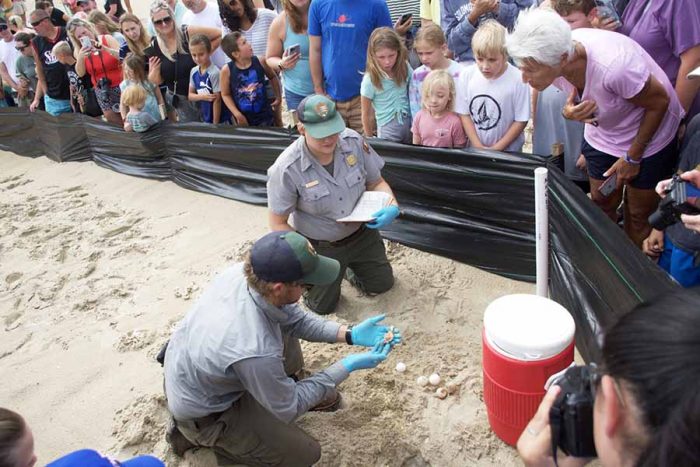
About 100 people or so gathered around Cape Hatteras National Seashore (CHNS) Resource officers Ash Keiper-Kintz and Mike Puckett as they carefully reached down into the loggerhead turtle nest and brought eggs to the surface.
The focus of their attention was the Aug. 26 sea turtle next excavation at Cape Hatteras Lighthouse beach.
Physically, the nest looks like a hole in the beach with sand stacked up around it. This particular nest had already boiled, or hatched, and Keiper-Kintz and Puckett were counting the unhatched eggs. They noted their appearance—whether they were damaged, or if there were signs of predation—and checked to see if there were any hatchlings that had not made it from the nest.
Among the eggs and occasional dead hatchling were four miniature loggerhead turtles, alive and ready to head to the sea. They were carefully placed in a bucket filled with sand to be released at night. The bright light of daytime could disorient them as they tried to crawl to the sea.
The children in the crowd craned their necks to get a look at the hatchlings, but the adults were just as curious, peering over the heads of the children, leaning into the barrier that kept the nest protected from beachgoers.
This particular nest had begun its journey on the north end of Buxton where there was a beach nourishment project earlier this summer. Part of the permitting process for beach nourishment requires a survey of sea turtle nests and the time needed to move the eggs to a safe location.

“It was originally laid in Buxton, in the area where beach nourishment was happening, and in order for that nourishment to continue, we were relocating nests in that general vicinity to areas outside of that nourishment zone,” said Jonathon Polk, CHNS Lead District Ranger.
As Polk describes it, moving a sea turtle nest is fairly straightforward process, although time consuming. The eggs are simply collected and then carried to the new location. “We’re creating a new nest cavity digging down and then putting the eggs into the nest, rather trying to move all the sand and everything” from the old nest, he said.
It’s been a good year for the sea turtle nesting. According to Polk there are over 300 nests in CHNS this year, with nests seen from the north end of the national seashore on Bodie Island to Ocracoke.
“This will be one of the highest nest totals that we’ve had for the season,” he said. “A few years ago in 2019, we had just over 400 nests. In 2016, there was about 350…I know this is definitely one of the higher numbers that we’ve had.”
Most of the nests’ occupants are loggerhead turtles, although occasionally, a green turtle or Kemp’s Ridley nest is found. Kemp’s Ridley and Green Turtles are classified as endangered species. Loggerhead turtles are considered endangered in some areas and threatened in others.
This year there has also been a leatherback turtle nest identified—which is very uncommon for North Carolina. Most leatherback nesting activity is on Mexican and Central American beaches.
“There was a leatherback nest this year. That’s pretty rare. There were a few other leatherback nests in North Carolina. We believe it was from the same nesting female. When they nest in a year, they may lay three nests,” Polk said. “But they don’t nest every year.”
The mortality rate of eggs in a nest can be fairly high, so even with more than 300 nests, it’s difficult to know exactly how productive this season is going to be.

“This year seems like things have been pretty successful,” Polk said. “We’re still right in the thick of our nesting season.”
The Park Service is planning additional excavations. It is a way, Polk explains, to demonstrate how natural resources are managed at CHNS.
“We are very excited for these opportunities. It gives the public more opportunities to experience what we do…We have a lot of folks that are extremely interested in the nesting sea turtles out here on the beach. This is an opportunity to get a more in-depth look at the science and the management that we have with these protected sea turtles,” he said.
The excavations are announced on the CHNS turtle hotline (252-475-9629). As Polk points out, they can’t be scheduled until the hatchlings emerge.
“These excavations only happen within a certain timeframe after these nests have hatched. So often there will only be 24 or 48 hours notice,” he said.









